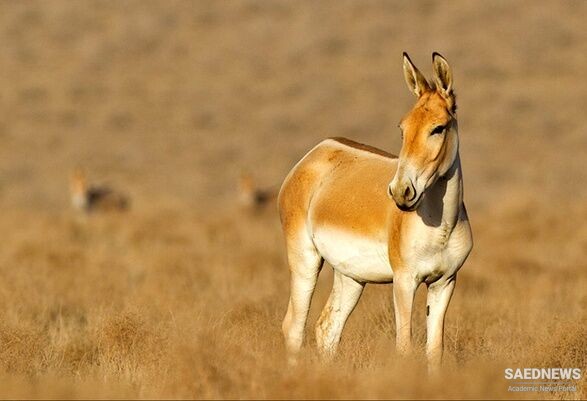This animal is in the category of mammals, a species of the Equidae family (horse family) and a sub–branch of the Asiatic. The Asian onager is different from the African zebra. Onager is often thought of as a striped animal.
But in fact, the striped ones belong to the African species of this creature. The Persian species of onagar has no black and white stripes and its color is light yellow-brown and has a white belly.
The coloration of their coat change with seasons, so their summer coat becomes a little darker and closer to red. There were six Asian species of this creature in the past, and their habitats were in the desert of different countries such as Syria, Mongolia, and China. Today, one of the Asian species of onager is extinct, and the rest in danger of extinction.

The history of the presence of this creature dates back many centuries ago which is evidenced by Iranian literature. The great Ferdowsi mentioned in his unique work “Shahnameh” about its existence a thousand years ago as mentioned elsewhere by Khayyam, the famous poet of the 11th century.
At first glance, this animal is very similar to a donkey, and in fact, Asian onager is also called a wild ass.
Persian onager is bigger and stronger than a donkey, but smaller than a horse, unlike horses and donkeys, it is not domesticated at all. Persian onager runs at an average speed of 50km/hr.
In the not so distant past, the habitats of Persian onager were in the semi-desert area of Iran such as Qazvin, Neyriz Fars, Sirjan in Kerman province, Abarghoo (Abarkuh) and Herat in Yazd province, Tabas in South Khorasan province, Sarakhs in North Khorasan province, around Varamin and Isfahan.
Today due to the decrease in population of this species, its habitats are limited to Bahram Gor in Fars province, Siah Kooh Ardakan National Park in Yazd province, Khar Turan, and Kavir National Park in Semnan province. Persian onager lives freely in these protected areas.
Persian onagers are highly gregarious creatures and live in herds. Sometimes they migrate to the warmest regions due to the cold climate and the cooler climate in summer. In addition to the mentioned areas, fences are used to keep Persian onager in regions such as Gurab, Tang Hana in Yazd province, Khabar in Kerman province, Darreh Bagh in Fars province, and Turan in Semnan province.
Due to the habitat type of Persian onager which is in the semi-arid desert to desert regions, their essential nutrition is also included the common plants of desert regions such as Gaz (Tamarix), Artemisia, etc.
The preservation of Persian onager survival is very important because other animals such as cheetahs and leopards feed on this creature to survive in the natural cycle. As a result, with the decline of this creature, other species of animals will be exposed to extinction.


 Persian Historical Houses: Zinat Al-Molk House, Shiraz
Persian Historical Houses: Zinat Al-Molk House, Shiraz














































